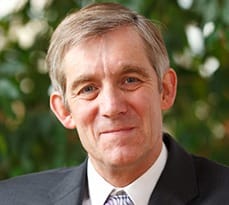Dr Chris Hope, Reader in Policy Modelling at Cambridge Judge Business School, co-authored a paper about permafrost thaw that was published in September 2015 in the prestigious journal Nature Climate Change, which has since been cited in 15 other research papers or books. The paper said that emissions of methane and carbon dioxide from the Arctic permafrost could result in an extra $43 trillion in additional economic damage by the end of the next century, an increase of 13% from damage already estimated from ‘standard’ greenhouse gas emissions. “The extra impacts,” the paper concluded, “are sufficiently high to justify urgent action to minimise the scale of the release.”
What’s unusual, and possibly unique, about the paper (entitled “Economic impacts of carbon dioxide and methane released from thawing permafrost”) is that it started with a tweet, and Chris and his co-author, Kevin Schaefer of the University of Colorado, never met or even talked on Skype or the telephone.
Chris Hope explains how it all unfolded in cyberspace, followed by the thoughts of Kevin Schaefer:
Chris Hope says:

I was a relatively late convert to Twitter, beginning to tweet in 2012 (6 years after Twitter’s launch) but by November 2012 I had about 1,000 followers, including some journalists, owing to a climate change model (the PAGE09 Integrated Assessment Model) I developed that is used by the US Environmental Protection Agency and others in the environmental field. One of those Twitter followers was Roger Harrabin, the longtime Environment Analyst for the BBC.
On 27 November 2012, I saw a tweet by Roger Harrabin that said simply: “UNEP calls for IPCC report on permafrost melting” – with a link to a United Nations Environment Program (UNEP) report recommending that the Intergovernmental Panel on Climate Change (IPCC) address the impact of melting permafrost and the resulting methane and carbon dioxide emissions.
My interest was further piqued by a series of tweets involving myself, Roger Harrabin and Leo Hickman, then an environment journalist for The Guardian newspaper, and later that day I posted a blog post referencing the UNEP report.
The blog post noted that while the report didn’t include monetary estimates of the effect of permafrost melting, it “fortunately” included a graph which plots the extra emissions that could result from such melting – a graph that stemmed from a research paper a year earlier co-authored by Kevin Schaefer of the National Snow and Ice Data Centre at the University of Colorado in Boulder, lead author of the UNEP report.
Running the numbers through the PAGE09 model, I estimated that the extra impact from these emissions would increase global mean temperature by between 0.03 and 0.08 degrees (Centigrade) in 2100, and by between 0.05 and 0.12 degrees by 2150 – adding to “the possible inundation, storm surges, loss of agricultural output and ecosystem loss that we already expect climate change might bring in its wake.”
Ten days later, I emailed Kevin Schaefer to let him know that I had used his graph figures to do this ‘crude’ calculation of extra global impact from permafrost melting, and suggested “it might be worth doing a more accurate estimate of the extra global impacts”. I asked if he was willing to share more detailed data for more time periods – for 2010, 2020, 2030, 2040, 2050, 2075 and 2100.
“Of course,” Kevin replied, asking whether I needed monthly or annual breakdowns and offering to help as needed. He also asked whether I planned to write a paper about the findings. An email correspondence flowed from there that eventually led to us drafting different sections of the paper, melding those drafts, and arriving at a final version that became the co-authored Nature Climate Change paper.
Looking back at it now, I think it worked out very well to communicate the way we did exclusively online, because our areas were complementary – I was no expert in the kind of modelling he did, and vice versa. So working together we combined the internationally recognised physical model Kevin and his colleagues had developed with the state-of-the-art integrated model we developed. I guess the only drawback was that not being in the same building we couldn’t prod each other along, but the paper was submitted to Nature Climate Change on 7 November 2013, within a year of the initial tweet – which is not a long time by the standards of academic research.
I would certainly do this kind of collaboration again – but as in this case it would need to be with someone whose work I was familiar with, one of the leading figures in the field. I think it worked out really well, and the paper has resonated with other academics and policy makers.
Kevin Schaefer says:
My involvement started with an email from Chris asking for estimates of CO2 and methane fluxes from my simulations of the permafrost carbon feedback to use as input to his economic model. Our 2 models are so different in structure and purpose that it took several weeks to get useful results. We found the results very interesting, so we decided to publish them in a paper. Writing the initial draft took only a few weeks, but the iterations during review took months. Linking 2 such different models was so new that one of the reviewers simply did not believe our results. We spent months on rewrites to satisfy the reviewer’s concerns. Finally, we wrote a model description in the supplementary material that maxed out the length limits, the reviewer relented, and Nature Climate Change published the paper.
The project occurred entirely in cyberspace via email. Phone calls and Skype proved impossible because of the 8-hour time difference between Colorado and Cambridge. The email exchange fell into a pattern: each respond while the other slept. I would get an email from Chris in the morning and reply by the end of my day, or the middle of the night in Cambridge. Chris would then respond to my email while I slept. In a year we had a paper, an astounding pace for such a complicated topic.
We came to know each other quite well through our emails. I hope to meet Chris in person the next time I travel to England or if we happen to attend the same conference.
A simple tweet triggered an email that resulted in a nice paper. Our paper, along with thousands of other papers, finally tipped the scales in the negotiation of the Paris accord. We started a new line of research linking integrated assessment with physical models. Policy makers desperately need such models as we move from simply studying climate change to actually doing something about it under the Paris Accord. To date, we have not seen great reductions in emissions, but I feel hopeful about the future. I foresee a great shift in our global economy away from fossil fuels and feel Chris and I in our small way will help.


